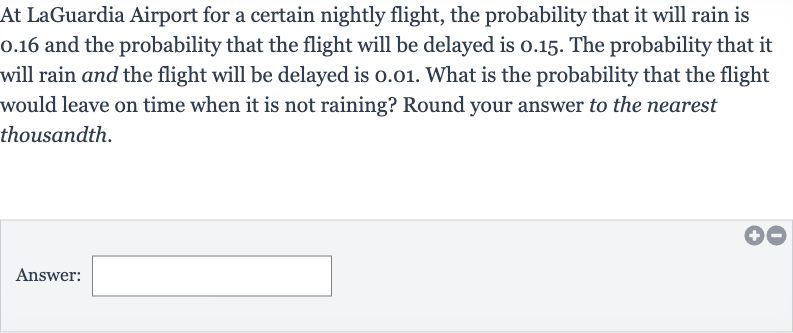AI tutor
Welcome to Bytelearn!
Let’s check out your problem:

At LaGuardia Airport for a certain nightly flight, the probability that it will rain is . and the probability that the flight will be delayed is . . The probability that it will rain and the flight will be delayed is . . What is the probability that the flight would leave on time when it is not raining? Round your answer to the nearest thousandth.Answer:
Full solution
Q. At LaGuardia Airport for a certain nightly flight, the probability that it will rain is . and the probability that the flight will be delayed is . . The probability that it will rain and the flight will be delayed is . . What is the probability that the flight would leave on time when it is not raining? Round your answer to the nearest thousandth.Answer:
- Calculate : Let's denote the events as follows:: It will rain.: The flight will be delayed.: It will not rain (the complement of ).: The flight will leave on time (the complement of ).We are given the following probabilities:We want to find , which is the probability that the flight leaves on time and it is not raining.First, we need to find , which is the probability that it does not rain. This is the complement of , so we calculate it as:
- Find : Next, we need to find , which is already given as . To find , we calculate the complement of :
- Use Probability Rules: Now, we need to find , but we don't have this probability directly. We can use the fact that is related to , , and .We know that , because the events and are mutually exclusive and their union is the event .So we can write:
More problems from Find probabilities using the addition rule
QuestionGet tutor help
QuestionGet tutor help
QuestionGet tutor help
QuestionGet tutor help
QuestionGet tutor help
QuestionGet tutor help
QuestionGet tutor help
QuestionGet tutor help
QuestionGet tutor help
